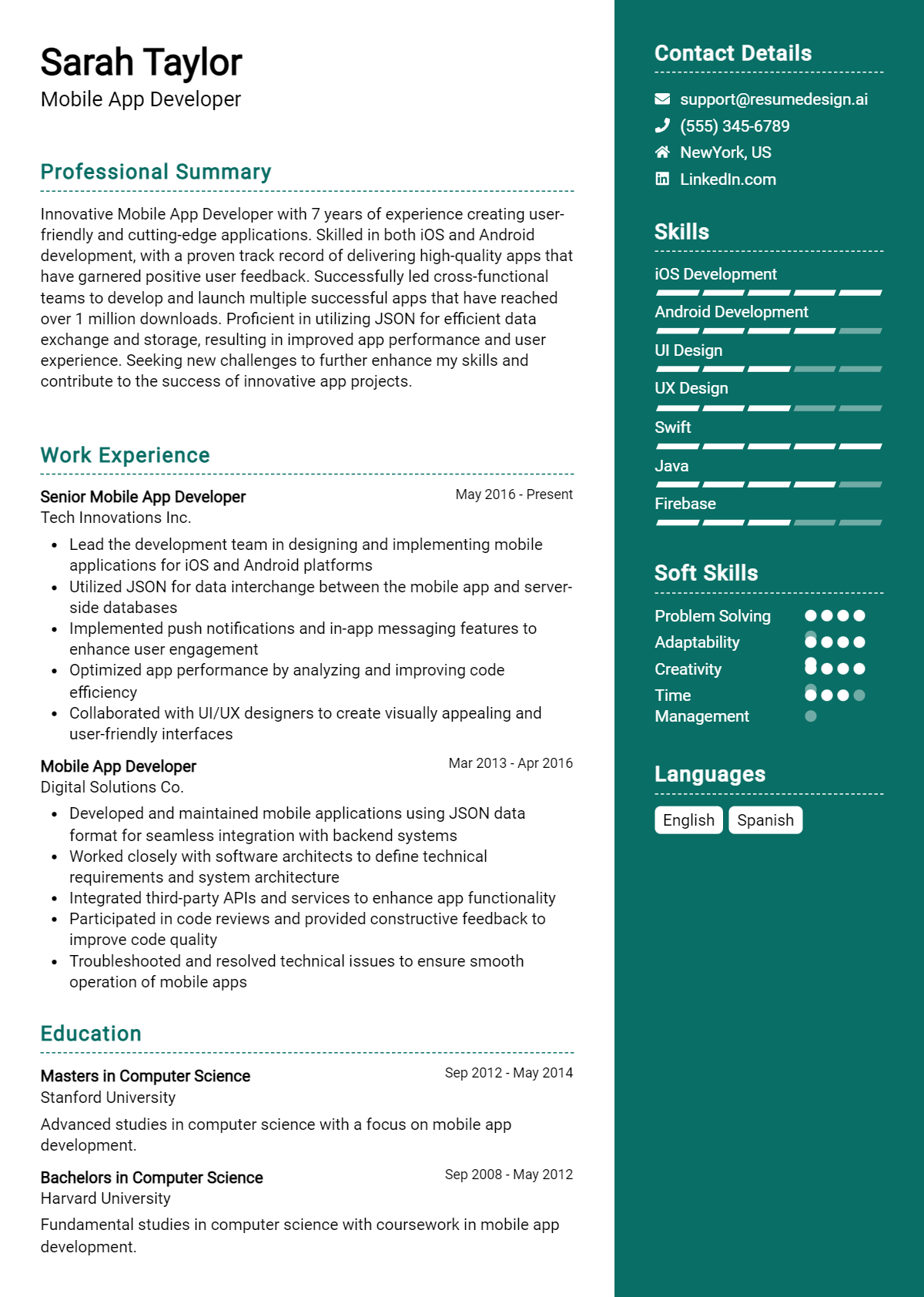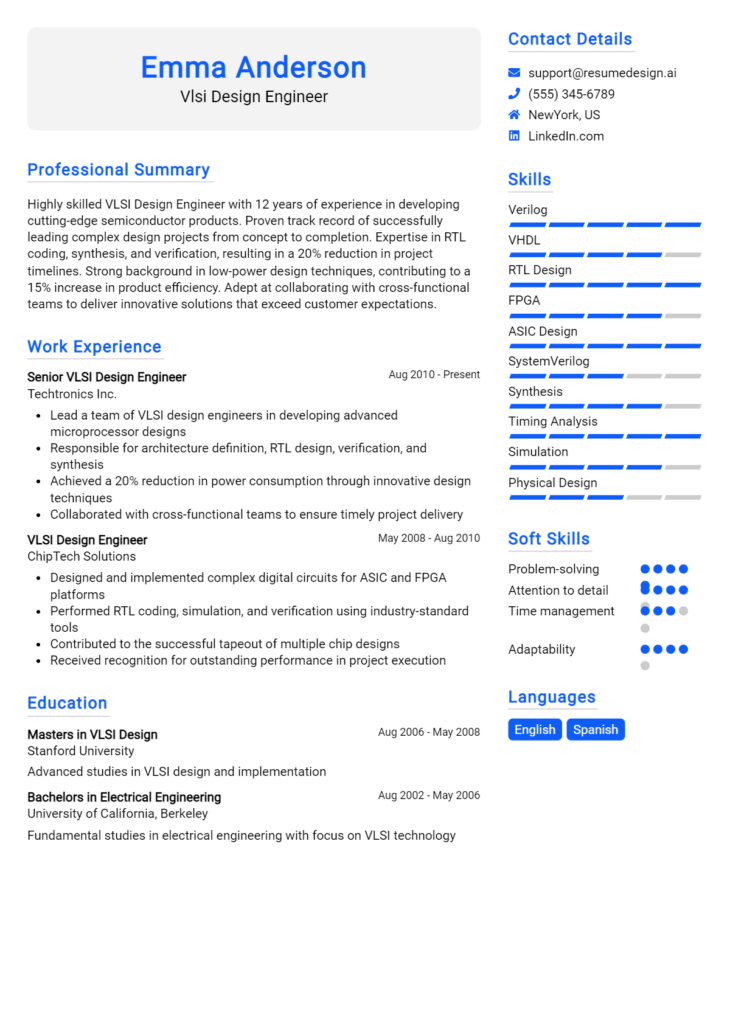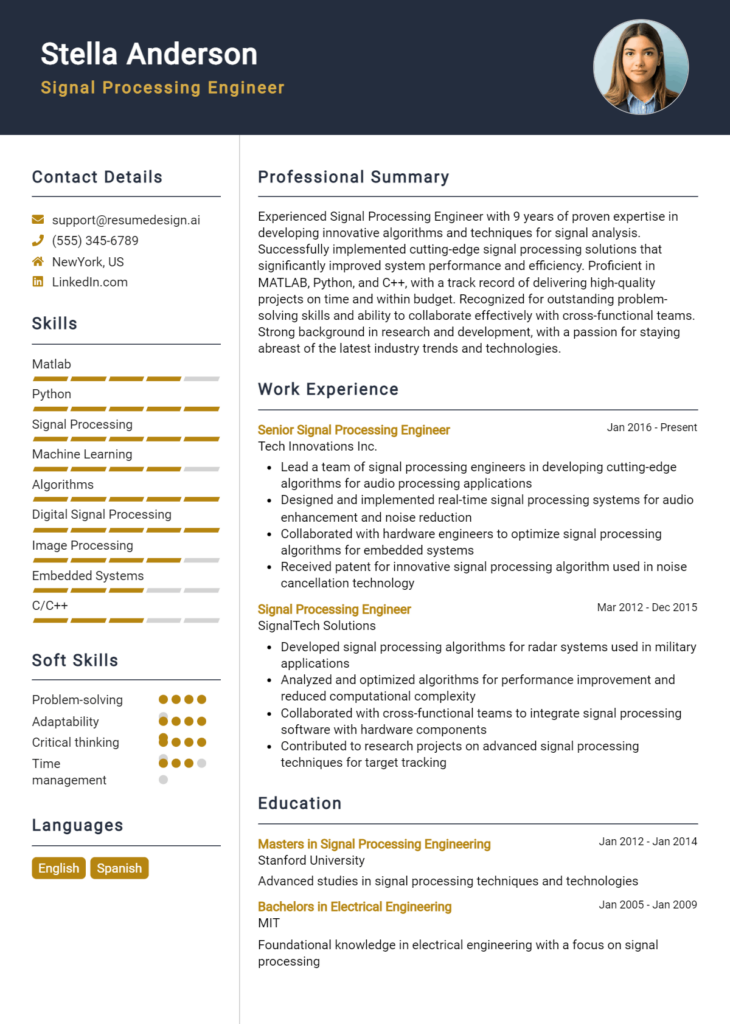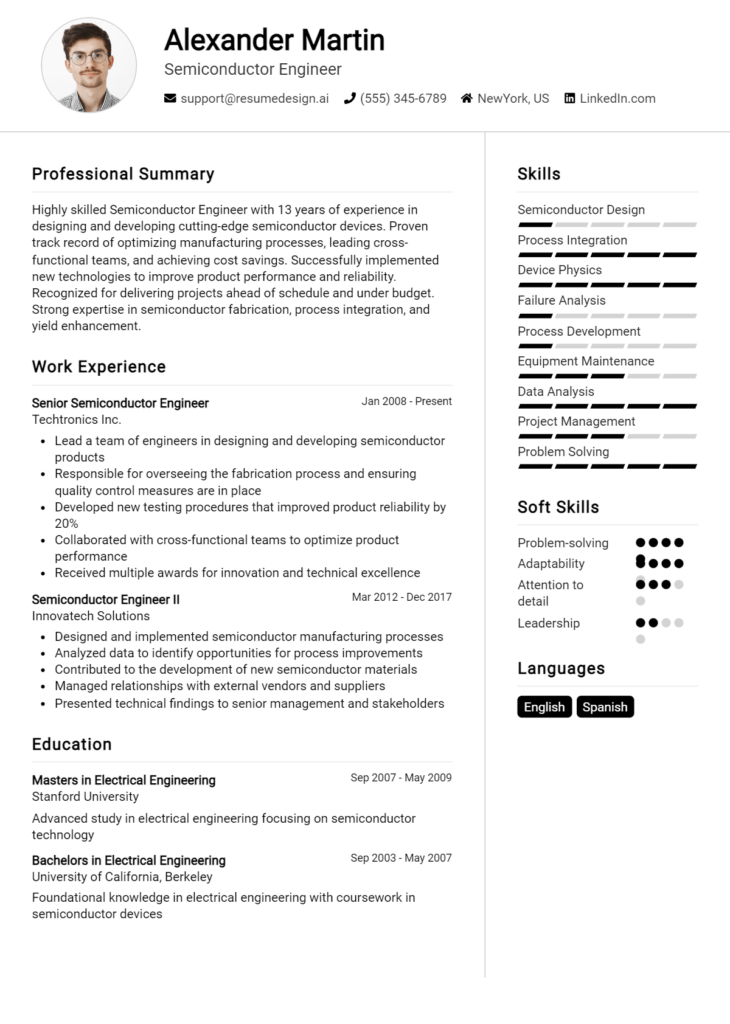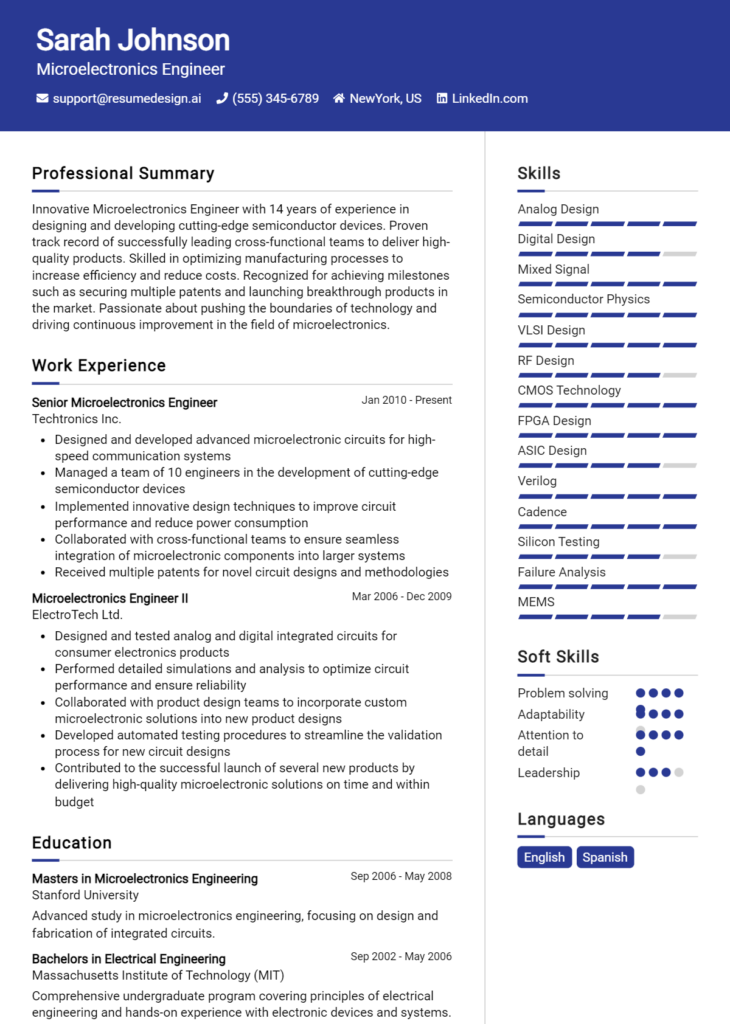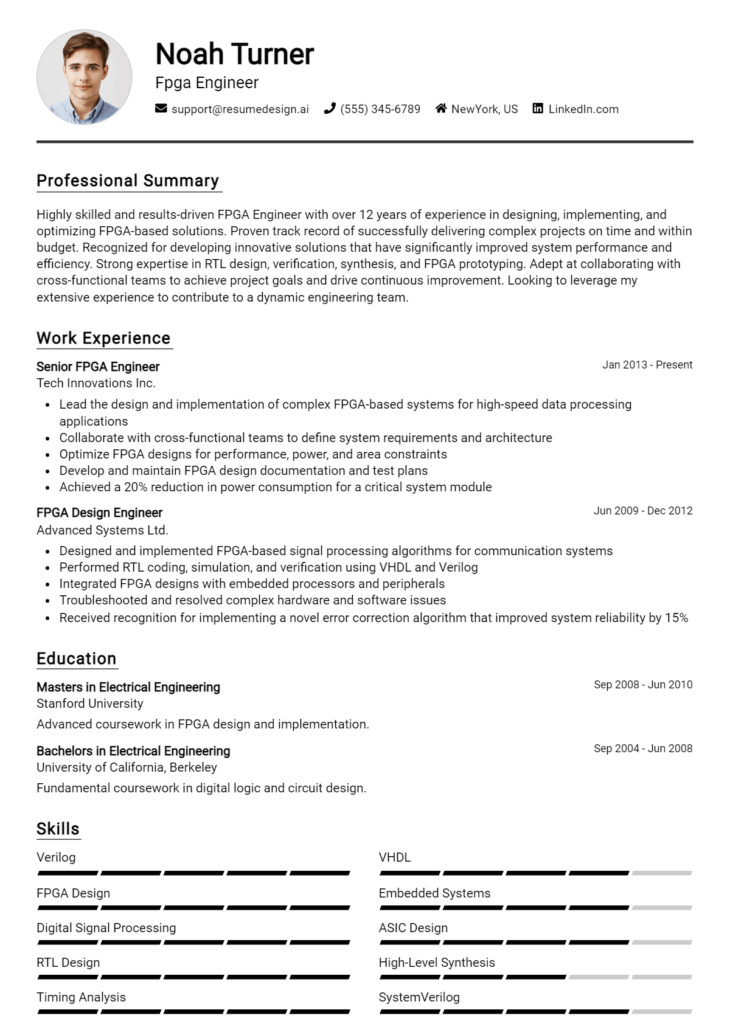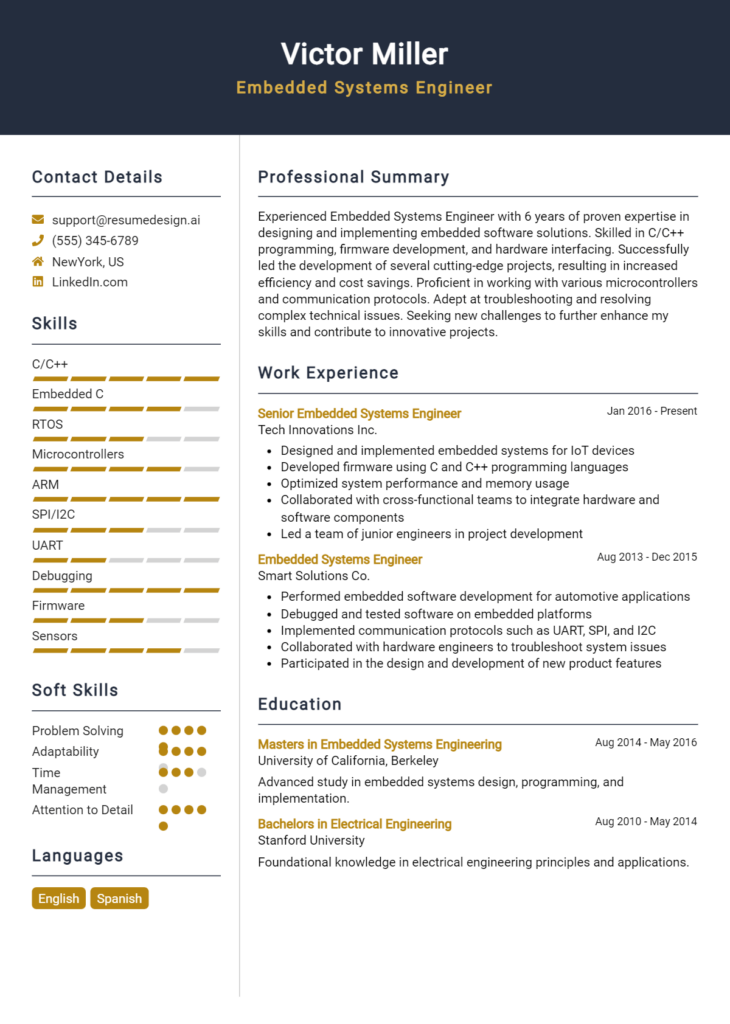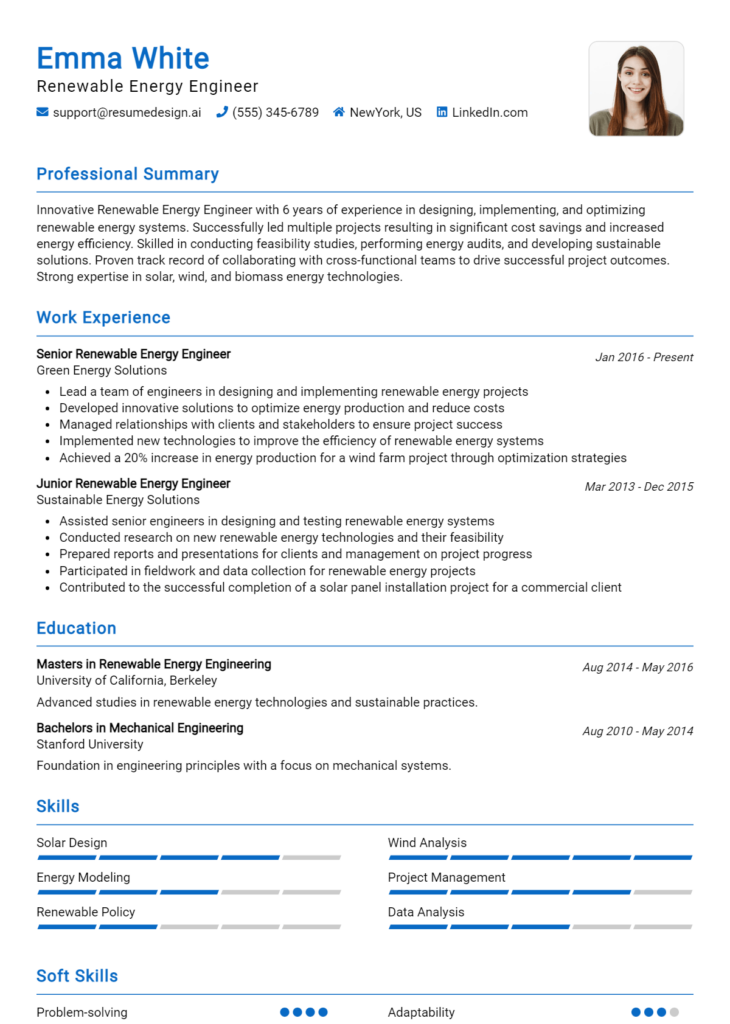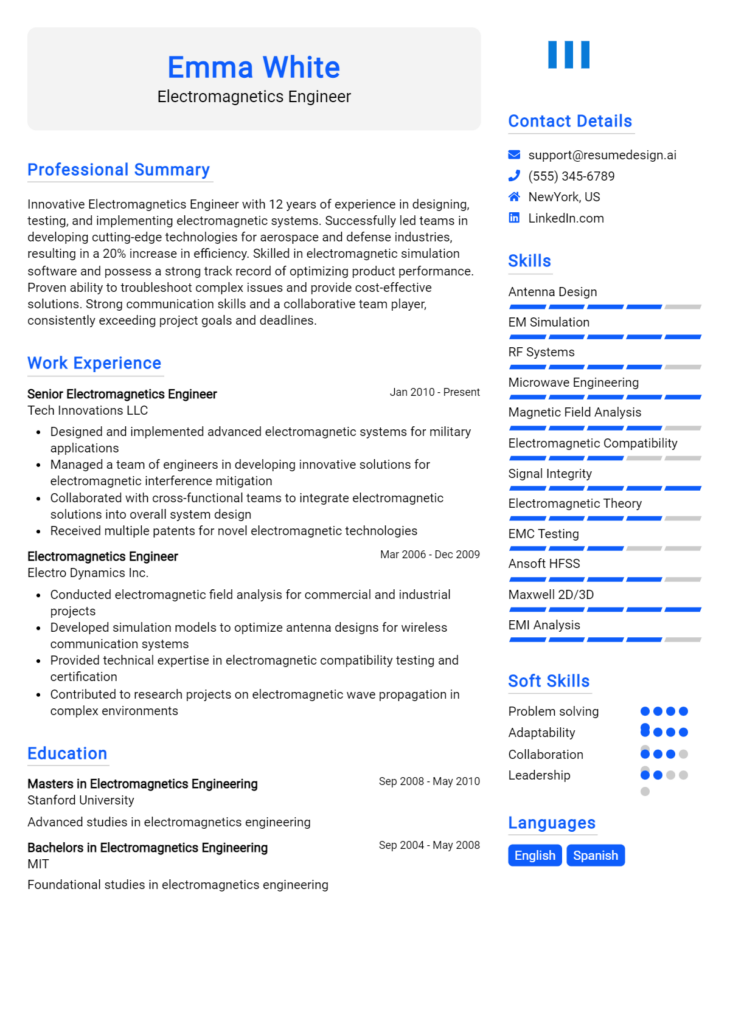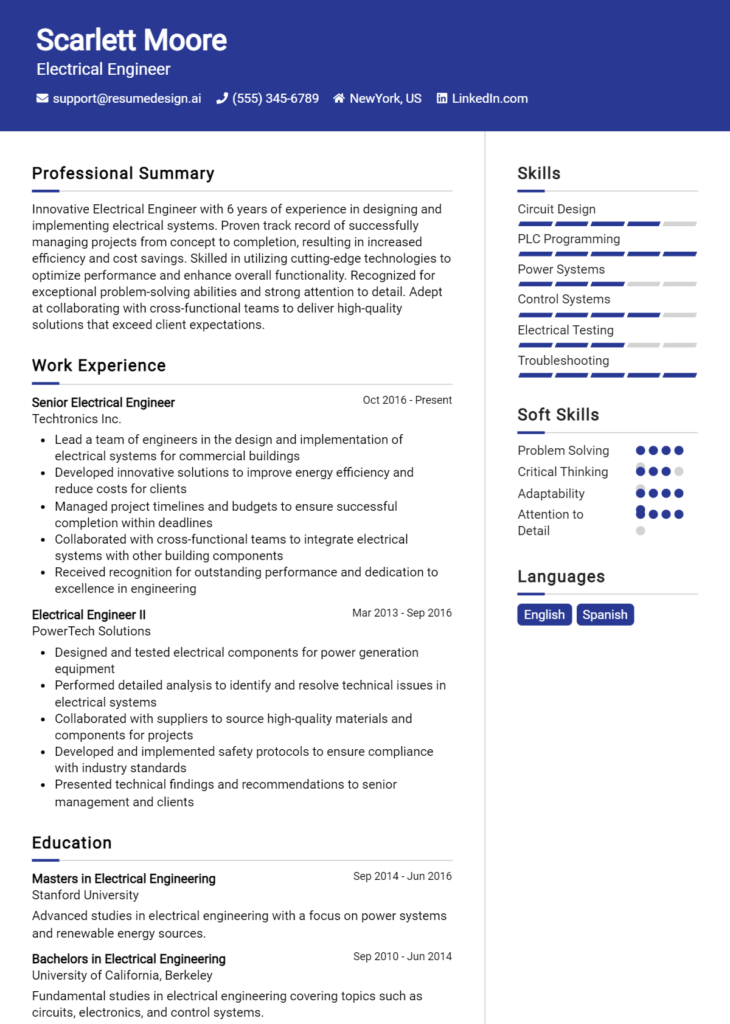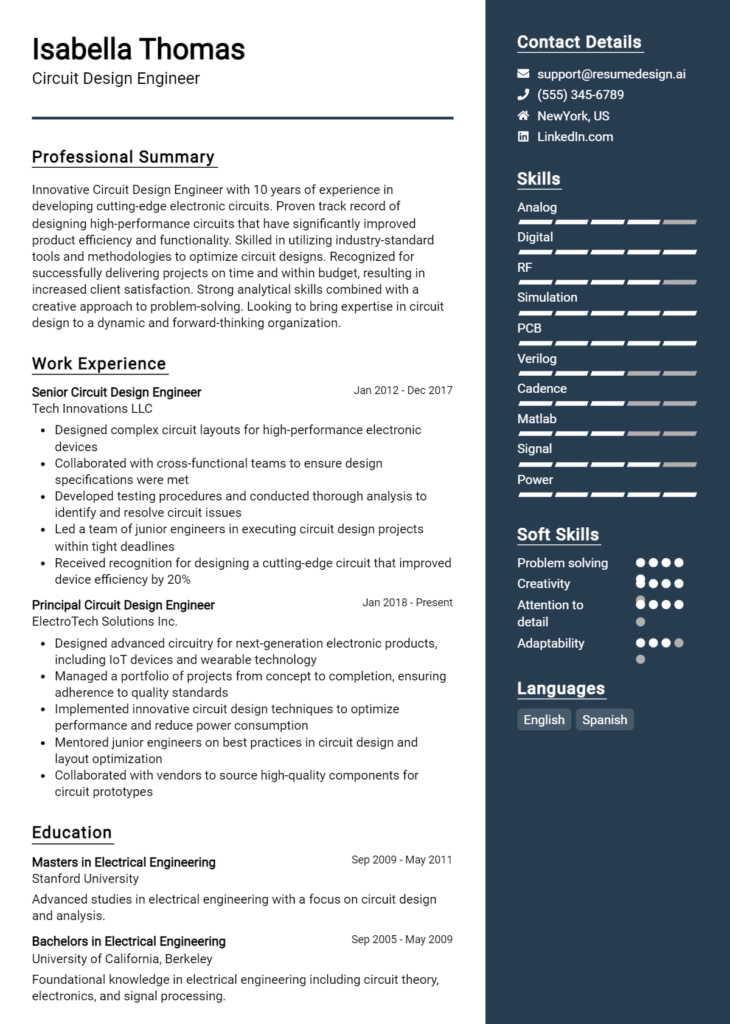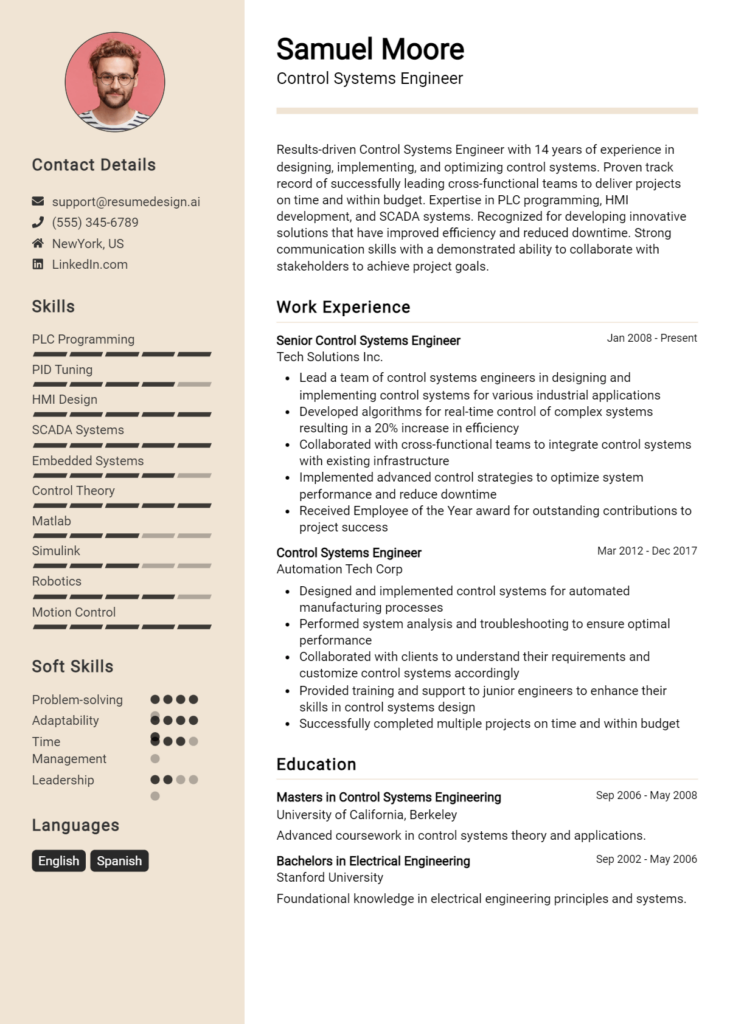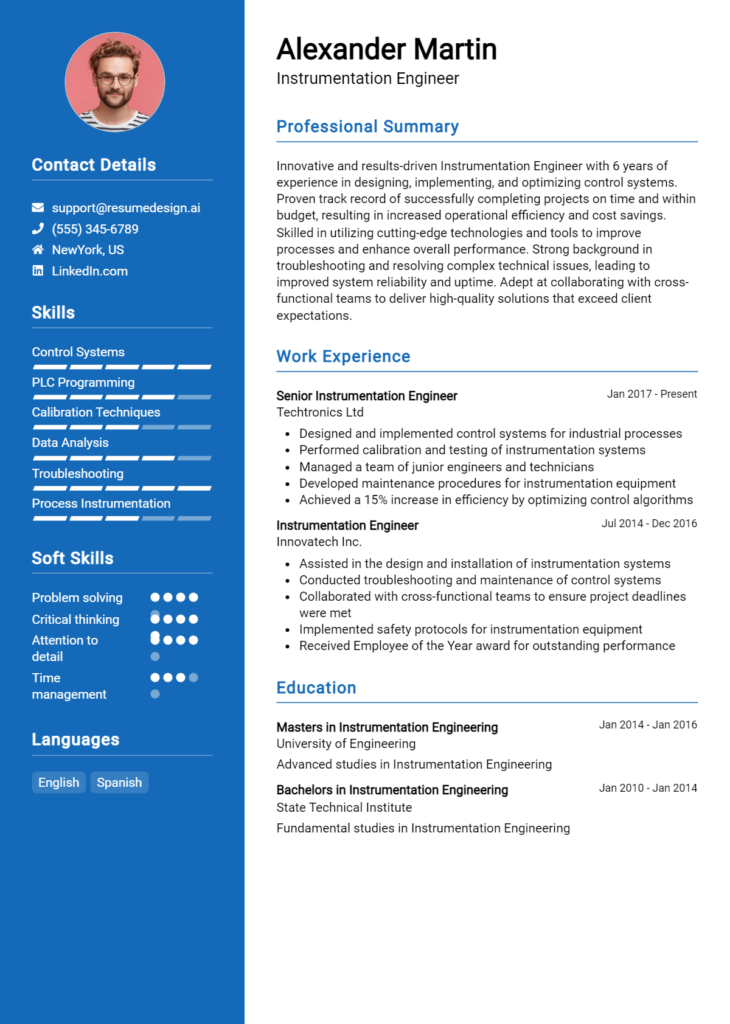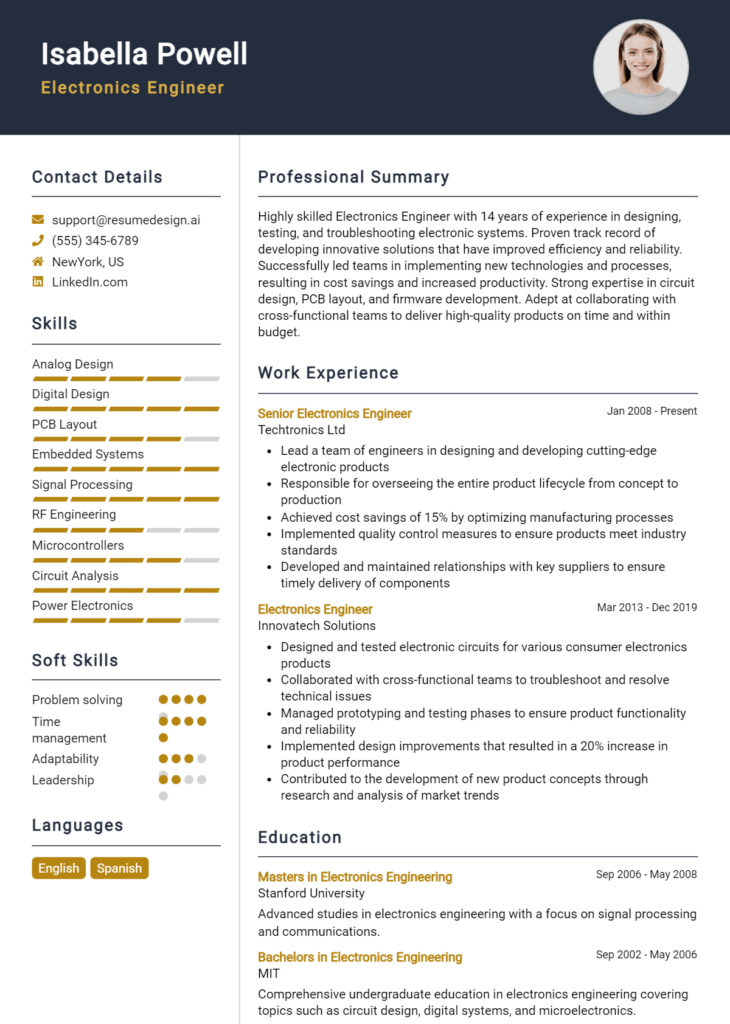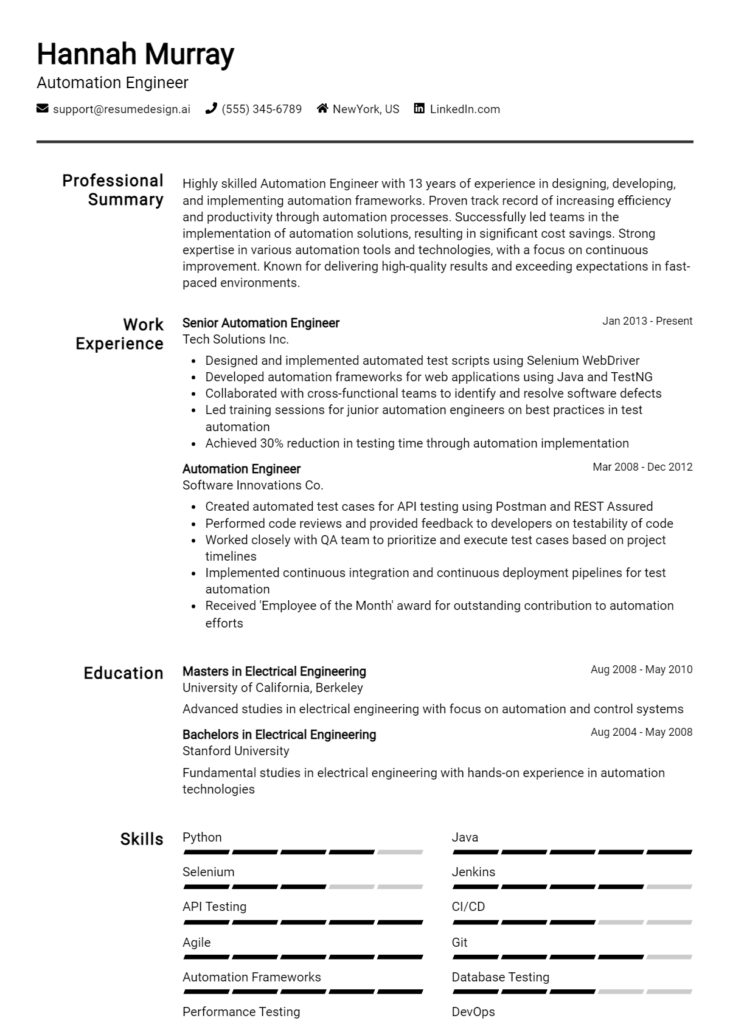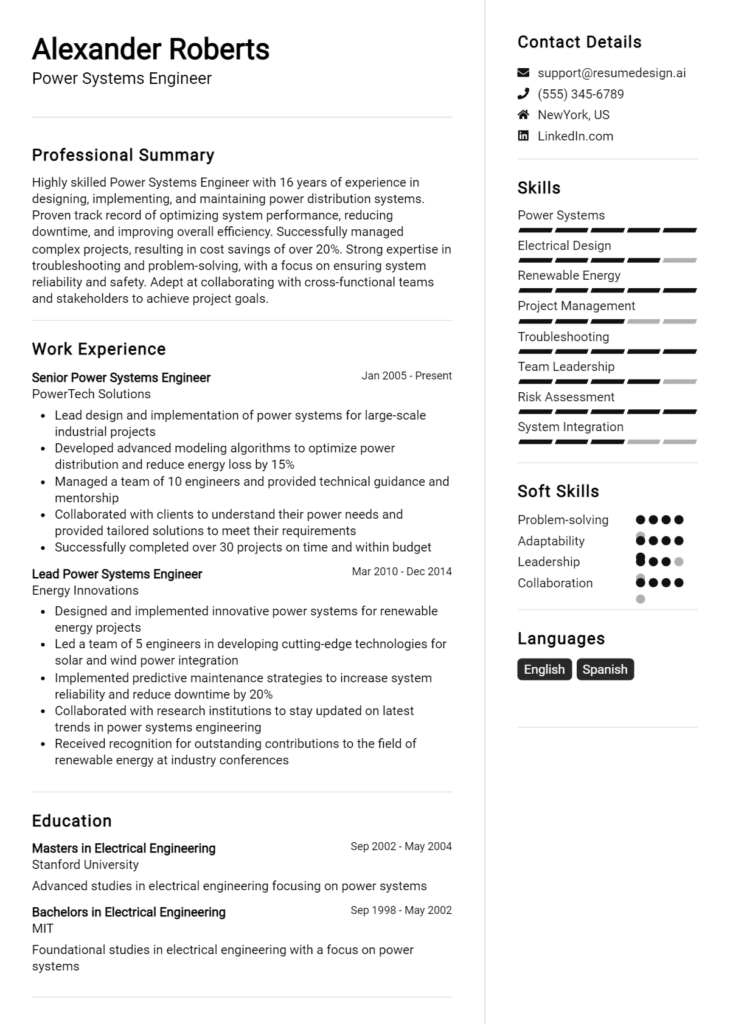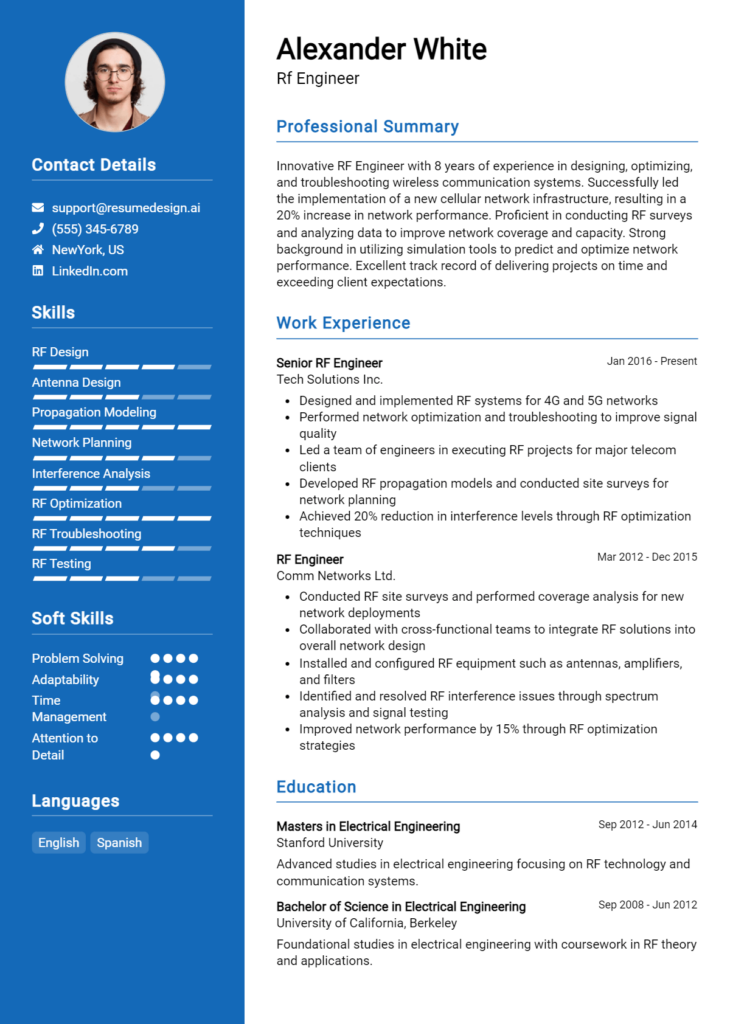PCB Design Engineer Core Responsibilities
A PCB Design Engineer is essential in translating electronic concepts into functional designs, bridging the gap between engineering, manufacturing, and quality assurance teams. Key responsibilities include designing layout schematics, testing prototypes, and ensuring compliance with industry standards. Successful engineers must possess strong technical skills in CAD software, operational knowledge of electronics, and exceptional problem-solving abilities. These skills are vital in meeting organizational goals, and a well-structured resume can effectively showcase these qualifications to potential employers.
Common Responsibilities Listed on PCB Design Engineer Resume
- Design and develop PCB layouts according to specifications.
- Collaborate with cross-functional teams to integrate electronic components.
- Conduct design reviews and ensure adherence to industry standards.
- Perform signal integrity analysis and troubleshooting.
- Utilize CAD tools for schematic capture and PCB layout.
- Prepare technical documentation and reports for manufacturing.
- Test prototypes and evaluate performance against specifications.
- Identify and resolve design issues during the development process.
- Stay updated on industry trends and emerging technologies.
- Assist in the selection of appropriate materials and components.
- Ensure compliance with regulatory requirements and safety standards.
- Provide support during the manufacturing and assembly phases.
High-Level Resume Tips for PCB Design Engineer Professionals
In the competitive field of PCB (Printed Circuit Board) design, a well-crafted resume is crucial for making a strong first impression on potential employers. Your resume serves as a personal marketing tool that not only showcases your technical skills and design expertise but also highlights your achievements and contributions to past projects. It's essential for PCB Design Engineer professionals to create a resume that reflects their unique qualifications and aligns with the specific needs of each job opportunity. This guide will provide practical and actionable resume tips tailored to help you stand out in the PCB design industry.
Top Resume Tips for PCB Design Engineer Professionals
- Customize your resume for each job application by incorporating keywords from the job description to align your experiences with employer expectations.
- Highlight your relevant experience in PCB design, including the types of circuits and technologies you've worked with, to demonstrate your expertise.
- Quantify your achievements by including specific metrics, such as the number of successful projects completed, reduction in production costs, or improvements in design efficiency.
- Showcase industry-specific skills, such as proficiency in PCB design software (e.g., Altium Designer, Eagle, OrCAD) and knowledge of design for manufacturability (DFM) principles.
- Include a summary or objective statement at the top of your resume that clearly outlines your career goals and relevant skills.
- List certifications and professional development courses relevant to PCB design, such as IPC certification, which can set you apart from other candidates.
- Incorporate a section for projects where you can detail specific PCB design projects, including your role, the technologies used, and the impact of your contributions.
- Use clear and concise language, avoiding jargon that may not be familiar to all hiring managers, while still showcasing your technical competency.
- Ensure your resume is well-organized and visually appealing, using consistent formatting and bullet points for readability.
By implementing these tips, PCB Design Engineer professionals can significantly enhance their resumes, making them more appealing to potential employers. A polished and targeted resume can increase the chances of landing job interviews and ultimately securing a position in this dynamic field.
Why Resume Headlines & Titles are Important for PCB Design Engineer
In the competitive field of PCB design engineering, a well-crafted resume headline or title serves as a critical tool for job seekers to make a strong first impression. A powerful headline can instantly capture the attention of hiring managers, succinctly summarizing a candidate's key qualifications in just a few impactful words. It should be concise, relevant, and directly tailored to the specific role being applied for, ensuring that it resonates with the skills and experiences that employers are looking for. A compelling headline sets the tone for the rest of the resume, encouraging hiring managers to delve deeper into the applicant's qualifications and achievements.
Best Practices for Crafting Resume Headlines for PCB Design Engineer
- Keep it concise, ideally under 10 words.
- Focus on role-specific keywords that align with the job description.
- Highlight your most relevant technical skills or certifications.
- Incorporate quantifiable achievements when possible.
- Avoid vague language; be specific about your expertise.
- Use action-oriented words to convey a sense of initiative.
- Tailor your headline for each position you apply to.
- Consider including years of experience to establish credibility.
Example Resume Headlines for PCB Design Engineer
Strong Resume Headlines
"Innovative PCB Design Engineer with 5+ Years of Experience in High-Frequency Circuitry"
“Expert in Multi-Layer PCB Design and Signal Integrity Analysis”
“Results-Driven PCB Engineer Specializing in Cost-Effective Solutions and Prototyping”
Weak Resume Headlines
“Engineer Seeking Opportunities”
“PCB Designer with Some Experience”
The strong headlines are effective because they are specific, clearly outlining the candidate's expertise and achievements while incorporating relevant keywords that align with the job requirements. They demonstrate confidence and provide a snapshot of what the candidate brings to the table. In contrast, the weak headlines fail to impress due to their vagueness and lack of detail; they do not convey any unique value or specialization, making it difficult for hiring managers to see why the candidate would be a strong fit for the role.
Writing an Exceptional PCB Design Engineer Resume Summary
A well-crafted resume summary is crucial for a PCB Design Engineer, as it serves as the first impression a hiring manager will have of the candidate. This brief introductory paragraph should effectively encapsulate the applicant's most relevant skills, experience, and achievements, allowing them to stand out in a competitive job market. An impactful summary is concise yet powerful, tailored specifically to the job description, and designed to quickly capture attention, thereby encouraging the hiring manager to delve deeper into the resume.
Best Practices for Writing a PCB Design Engineer Resume Summary
- Quantify achievements: Use numbers to demonstrate the impact of your work, such as percentage improvements or cost savings.
- Focus on relevant skills: Highlight key PCB design skills such as schematic capture, layout design, and familiarity with CAD tools.
- Tailor the summary: Customize the summary for each job application to align with the specific requirements listed in the job description.
- Be concise: Aim for 2-4 sentences that convey your strongest qualifications without unnecessary detail.
- Use action verbs: Start sentences with dynamic verbs that convey proactivity and competence.
- Showcase relevant experience: Mention specific industries or projects that relate to the job you’re applying for.
- Include certifications: Highlight any professional certifications related to PCB design that may enhance your candidacy.
Example PCB Design Engineer Resume Summaries
Strong Resume Summaries
Dynamic PCB Design Engineer with over 5 years of experience in developing high-performance circuit boards for consumer electronics. Achieved a 30% reduction in production costs while enhancing product reliability through innovative design techniques.
Detail-oriented PCB Designer skilled in Altium Designer and Eagle CAD, delivering over 50 successful projects in the telecommunications sector. Recognized for improving design accuracy by 25% through rigorous testing and validation processes.
Results-driven PCB Design Engineer with a proven track record of leading cross-functional teams to deliver complex electronic solutions. Successfully reduced time-to-market by 15% on key projects by implementing Agile methodologies.
Weak Resume Summaries
Experienced engineer with skills in PCB design. Looking for a new opportunity in a challenging environment.
PCB Designer with some experience in various projects. I am a hard worker and eager to learn more.
The strong resume summaries stand out because they provide specific achievements and quantifiable results, demonstrating the candidate's impact in previous roles. They also clearly outline relevant skills and experiences, making them appealing to hiring managers. In contrast, the weak summaries are vague and lack detail, failing to convey any measurable success or specific expertise, which diminishes their effectiveness in capturing the hiring manager's interest.
Work Experience Section for PCB Design Engineer Resume
The work experience section of a PCB Design Engineer resume is critical as it serves as a primary showcase of the candidate's technical skills, project management abilities, and capacity to deliver high-quality products. This section not only highlights the candidate's hands-on experience with PCB design tools and methodologies but also demonstrates their ability to lead teams and collaborate effectively with cross-functional groups. Quantifying achievements, such as project timelines, budget management, and product performance metrics, is crucial in establishing credibility and aligning the experience with industry standards, making a compelling case for the candidate's expertise and suitability for the role.
Best Practices for PCB Design Engineer Work Experience
- Highlight specific PCB design software proficiency (e.g., Altium, Cadence).
- Quantify achievements with metrics (e.g., reduced production costs by 20%).
- Showcase leadership roles in project management or team collaboration.
- Detail the types of PCBs designed (e.g., multilayer, RF, high-speed).
- Include relevant certifications or training related to PCB design.
- Align experience descriptions with industry standards and best practices.
- Emphasize successful project outcomes and client satisfaction ratings.
- Demonstrate continuous improvement through iterations or feedback implementation.
Example Work Experiences for PCB Design Engineer
Strong Experiences
- Led a team of 5 engineers in developing a 10-layer PCB for a new telecommunications product, achieving a 15% reduction in signal loss compared to previous designs.
- Implemented a design-for-manufacturability process that decreased production time by 30%, resulting in cost savings of $50,000 annually.
- Collaborated with cross-functional teams to successfully launch three high-speed PCB products in the market, achieving a customer satisfaction score of 95%.
- Utilized advanced simulation tools to predict thermal performance, resulting in a 25% improvement in operational reliability for a critical medical device PCB.
Weak Experiences
- Worked on various PCB designs without specifying types or technologies used.
- Assisted in projects that involved PCB design but did not detail contributions or outcomes.
- Involved in team meetings related to PCB development.
- Gained experience in electronics but failed to highlight specific skills or tools.
The examples provided illustrate the distinction between strong and weak experiences. Strong experiences are characterized by clear, quantifiable outcomes and specific technical contributions, showcasing leadership and collaboration. In contrast, weak experiences lack detail and measurable impact, failing to convey the candidate's value or expertise in PCB design engineering.
Education and Certifications Section for PCB Design Engineer Resume
The education and certifications section of a PCB Design Engineer resume is crucial as it showcases the candidate's academic background and specialized training relevant to the field. This section not only highlights formal education, such as degrees in electrical engineering or electronics, but also emphasizes industry-recognized certifications that demonstrate a commitment to continuous learning and professional development. By providing relevant coursework, certifications, and specialized training, candidates can enhance their credibility and illustrate their alignment with the job role, making them more competitive in the job market.
Best Practices for PCB Design Engineer Education and Certifications
- List relevant degrees prominently, focusing on engineering or technology fields.
- Include industry-recognized certifications such as IPC Designer Certification or Certified Electronics Technician.
- Provide details on specialized training or workshops related to PCB design software and methodologies.
- Highlight relevant coursework that pertains to PCB design, such as circuit design or signal integrity.
- Stay updated with new certifications to demonstrate continuous professional development.
- Use clear formatting to differentiate between degrees, certifications, and other training for easy readability.
- Tailor the information specifically to the job application, focusing on the most relevant qualifications.
Example Education and Certifications for PCB Design Engineer
Strong Examples
- Bachelor of Science in Electrical Engineering, University of Technology, 2020
- IPC CID (Certified Interconnect Designer), 2021
- Relevant Coursework: Advanced PCB Design, Signal Integrity Analysis, and Electronics Manufacturing Processes
- Completed Training on Altium Designer and KiCAD PCB Software, 2022
Weak Examples
- Bachelor of Arts in History, University of Arts, 2018
- Generic Project Management Certification, 2020
- Completed a workshop on Basic Computer Skills, 2021
- High School Diploma, 2015
The strong examples are considered effective because they directly relate to the skills and knowledge required for a PCB Design Engineer, showcasing relevant education and certifications that are recognized in the industry. In contrast, the weak examples illustrate qualifications that are either unrelated or too generic, failing to demonstrate the necessary expertise and commitment to the field of PCB design engineering.
Top Skills & Keywords for PCB Design Engineer Resume
As a PCB Design Engineer, showcasing your skills on your resume is crucial for standing out in a competitive job market. Employers seek candidates who not only possess the technical knowledge required for designing printed circuit boards but also have the soft skills necessary for effective collaboration and problem-solving. Highlighting a balanced combination of hard and soft skills can significantly enhance your chances of landing an interview. A well-crafted resume that emphasizes these competencies can demonstrate your capability to contribute to a team and drive projects to successful completion, making it an essential element of your job application.
Top Hard & Soft Skills for PCB Design Engineer
Soft Skills
- Strong communication skills
- Team collaboration and interpersonal skills
- Problem-solving abilities
- Analytical thinking
- Attention to detail
- Time management
- Adaptability and flexibility
- Project management
- Critical thinking
- Creative thinking
Hard Skills
- Proficiency in PCB design software (e.g., Altium Designer, Eagle, OrCAD)
- Knowledge of electronic circuits and components
- Experience with schematic capture and layout tools
- Understanding of signal integrity and electromagnetic compatibility
- Familiarity with manufacturing processes and materials
- Ability to perform design validation and testing
- Knowledge of industry standards (e.g., IPC standards)
- Proficient in using simulation tools (e.g., SPICE)
- Experience with CAD tools
- Understanding of embedded systems and firmware integration
For more details on how to showcase your skills and highlight your work experience, consider tailoring your resume to align with the specific requirements of the PCB Design Engineer role you are pursuing.
Stand Out with a Winning PCB Design Engineer Cover Letter
Dear Hiring Manager,
I am writing to express my interest in the PCB Design Engineer position at [Company Name] as advertised on [where you found the job listing]. With a Bachelor’s degree in Electrical Engineering and over [X years] of hands-on experience in PCB design and development, I am excited about the opportunity to contribute to your team. My expertise in using industry-standard design software, such as Altium Designer and Eagle, combined with a strong understanding of electronic principles, positions me well to take on the challenges presented in this role.
In my previous role at [Previous Company Name], I successfully led numerous projects that involved designing complex multi-layer PCBs for various applications, including consumer electronics and industrial automation. My attention to detail and adherence to best practices in layout design have consistently resulted in reliable and efficient circuit boards, reducing production costs and time-to-market. Moreover, my collaborative approach has allowed me to work closely with cross-functional teams to ensure that all design specifications are met while maintaining compliance with industry standards.
I am particularly drawn to [Company Name] due to its commitment to innovation and quality within the electronics sector. I am eager to bring my background in signal integrity, thermal management, and design for manufacturability to your projects. I am confident that my proactive problem-solving skills and dedication to continuous improvement will make a meaningful impact on your team. I look forward to the opportunity to discuss how my experience and vision align with the goals of [Company Name].
Thank you for considering my application. I hope to discuss my qualifications further and explore how I can contribute to the ongoing success of [Company Name]. I am looking forward to the possibility of working together and am available at your convenience for an interview.
Sincerely,
[Your Name]
[Your Phone Number]
[Your Email Address]
Common Mistakes to Avoid in a PCB Design Engineer Resume
Creating an effective resume as a PCB Design Engineer is crucial for standing out in a competitive job market. However, many candidates make common mistakes that can hinder their chances of landing an interview. Understanding these pitfalls can help you craft a resume that effectively showcases your skills and experiences. Below are some of the most frequent errors to avoid when preparing your PCB Design Engineer resume:
Overloading with Technical Jargon: While technical skills are essential, excessive jargon can alienate non-technical hiring managers. Use clear language to describe your expertise.
Neglecting Project Impact: Simply listing projects without detailing your specific contributions and the outcomes can diminish the resume's effectiveness. Highlight your role and the results achieved.
Lack of Customization: Submitting a generic resume can signal a lack of interest in the specific position. Tailor your resume to align with the job description and company values.
Ignoring Design Tools and Software: Failing to mention relevant PCB design tools (like Altium Designer, Eagle, or KiCAD) can lead to missed opportunities. Clearly list your proficiency in these tools.
Omitting Soft Skills: While technical abilities are important, soft skills like teamwork, communication, and problem-solving are equally critical. Be sure to include these attributes with examples.
Poor Formatting and Organization: A cluttered or unprofessional layout can detract from your qualifications. Use a clean, organized format with headings and bullet points for readability.
Skipping Proofreading: Typos and grammatical errors can create a negative impression. Always proofread your resume or enlist someone else to review it for clarity and correctness.
Inadequate Education or Certification Details: If you have relevant degrees or certifications, ensure they are prominently featured. Include specifics about your education, such as majors, institutions, and graduation dates.
Conclusion
As a PCB Design Engineer, your role is crucial in the electronics industry. You are responsible for designing and creating printed circuit boards that are essential for various electronic devices. In this article, we covered the key skills needed for success in this position, including proficiency in PCB design software, a strong understanding of electronic components, and a meticulous approach to problem-solving and troubleshooting. We also discussed the importance of staying updated with industry trends and advancements in technology.
To ensure that you present yourself effectively to potential employers, it’s vital to have a polished and professional resume that highlights your skills and experience. Take a moment to review your PCB Design Engineer resume and consider how well it reflects your qualifications.
To assist you in this process, a variety of resources are available. You can explore resume templates to find a design that suits your style. If you're looking for a more hands-on approach, try using the resume builder to craft a tailored resume. Additionally, reviewing resume examples can provide inspiration and insights into effective formats and content. Finally, don’t forget the importance of a strong introduction—check out the cover letter templates to complement your resume.
Take action now and refine your resume to ensure it stands out in a competitive job market!

